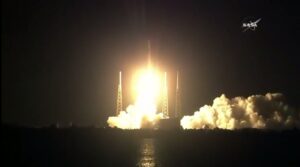SpaceX launches Dragon cargo spacecraft on final Block 4 mission

RENTON, Wash. — A SpaceX Falcon 9 successfully launched a Dragon cargo spacecraft early June 29 on the final flight of a Block 4 version of the rocket.
The Falcon 9 lifted off from Space Launch Complex 40 at Cape Canaveral Air Force Station, Florida, on schedule at 5:42 a.m. Eastern. SpaceX reported no problems during the countdown, and a technical issue with a thermal panel on the Dragon spacecraft, reported by the company at a pre-launch press conference June 28, was resolved prior to liftoff.
The launch is the last mission to use an older Block 4 version of the rocket. The first stage for this launch first flew April 18, carrying NASA’s Transiting Exoplanet Survey Satellite spacecraft. SpaceX did not attempt to perform a landing of the first stage on this launch, similar to other recent launches that has used previously-flown Block 4 first stages.
SpaceX will now use the upgraded Block 5 version of the Falcon 9 for all future launches. That version made its debut, and only flight to date, with the May 11 launch of the Bangabandhu-1 communications satellite for Bangladesh. The Block 5 includes a number of performance improvements and changes to allow for greater reuse of the first stage, with a goal of at least 10 launches for each booster.
The Dragon spacecraft is also reused, having previously flown the ninth mission in the company’s Commercial Resupply Services (CRS) contract with NASA in 2016. “For the remainder of the CRS-1 contract, which is through CRS-20, the plan is to use refurbished Dragons,” said Jessica Jensen, director of Dragon mission management at SpaceX, at the June 28 briefing.
When SpaceX shifts to its follow-on CRS-2 cargo delivery contract, the company will transition to the Dragon 2 vehicle, also known as Crew Dragon, that it is developing under its commercial crew contract. “What we’ll basically be doing is changing out seats and consoles for cargo accommodations,” she said.
On this mission, designated CRS-15, Dragon is carrying nearly 2,700 kilograms of cargo to the station. As is typical for such missions, the Dragon’s payload is a mix of crew supplies, space station hardware and experiments.
Among the payloads on the Dragon is one by Made In Space, a company that has developed a “pilot factory” for producing high-quality optical fibers using a material called ZBLAN. The company is analyzing fiber produced on the first two flights of the experiment while planning hardware for future missions to produce additional fiber, company president and chief executive Andrew Rush said during a panel discussion June 28 at the NewSpace 2018 conference here.
The Dragon’s trunk section carries two items of external cargo, an Earth science instrument called ECOsystem Spaceborne Thermal Radiometer Experiment on Space Station (ECOSTRESS) to study how plans respond to changes in water availability, and a new latching end effector, or “hand,” for the station’s robotic arm.
The payload on the Dragon that has received the most attention is one called Crew Interactive Mobile companion, or CIMON, a spherical computer with artificial intelligence algorithms. Researchers plan to see how CIMON can support crews on the station with an eye towards potential use on future long-duration exploration missions.
“Having AI, and having that knowledge base and the ability to tap into it in a way that’s useful for the task you’re doing is really critical for having humans further and further away from the planet,” said Kirk Shireman, NASA ISS program manager, at the June 28 briefing. “We’ll have to have autonomy, we’ll have to have tools like this to have the species successfully live far away from Earth.”
The Dragon is scheduled to arrive at the ISS on the morning of July 2, berthing with the station’s Harmony module. The spacecraft will spend a month at the station before returning to Earth.
from SpaceNews.com https://ift.tt/2MySmcI
Comments
Post a Comment